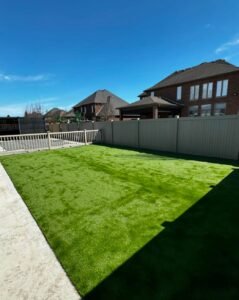Is it possible to have a lush, green lawn without the constant maintenance and watering? The answer is, yes. Many homeowners and businesses turn to artificial grass as a convenient alternative. But, as we aim for sustainability in all aspects of our lives, it’s essential to question the environmental impact of artificial grass. Read on as we unravel the various facets of how artificial grass affects our planet.
Water Conservation
The first and one of the most lauded benefits of artificial grass is its ability to conserve water. Traditional lawns with natural grass require a significant amount of water to maintain their aesthetic appeal. In contrast, artificial grass eliminates the need for watering, except for occasional cleaning. This can lead to substantial water savings, especially in arid regions or during periods of drought.
Chemical Runoff
A traditional lawn often necessitates the use of fertilizers, pesticides, and herbicides to remain healthy and pest-free. These chemicals can leach into the ground and contaminate local waterways, harming wildlife and ecosystems. Artificial grass requires no such treatments, reducing the potential for harmful runoff and underlining a beneficial aspect of its environmental impact of artificial grass.
Low–Maintenance
Maintaining a natural lawn involves regular mowing, which, in turn, contributes to carbon emissions, particularly from gasolical Runoffine-powered lawn mowers. Artificial grass eliminates the need for mowing, directly reducing the carbon footprint associated with lawn care. By choosing artificial turf solution, homeowners and businesses can play a part in lowering the emissions contributing to climate change.
Durability and Longevity
The durability and longevity of artificial grass also contribute to its positive environmental impact. High-quality artificial turf can last for many years, reducing the frequency of replacements and, consequently, the demand for new materials. This minimizes waste and the resources needed for manufacturing and transportation, further enhancing the sustainability profile of artificial grass.
Outdoor Use and Recreation
Artificial turf creates a durable, even, and safe surface that encourages outdoor activities in ways that natural lawns sometimes cannot. This resilience to heavy foot traffic without wear and tear or mud means spaces remain accessible for longer periods. By enabling more consistent and versatile use of outdoor areas, artificial grass contributes to the overall health and wellbeing of communities.
Versatility and Aesthetic Preservation
Finally, the versatility and aesthetic preservation associated with artificial grass are inherently beneficial. By providing a durable, attractive landscaping solution that withstands various weather conditions and usage patterns, artificial turf ensures that green spaces can be enjoyed year-round. This not only enhances the overall space aesthetically but also contributes to green environments.
At Turrific Turf, we understand the importance of making informed decisions that align with our sustainability goals. Thus, we are always committed to turning your landscaping dreams into reality while considering the environmental implications of the choices you make. If you’re contemplating artificial grass or seeking alternative sustainable landscaping solutions, reach out to us. Let’s work together to create beautiful, eco-friendly spaces that benefit both our communities and the planet.





